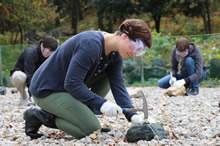About the Itoigawa UNESCO Global Geopark
Explore the birth of the Japanese Islands and a region of unparalleled diversity and beauty

Takanami-no-Ike Pond & the Limestone Face of Mt. Myojo
Intro to the Itoigawa UNESCO Global Geopark
The Itoigawa UNESCO Global Geopark is located along the Sea of Japan in Itoigawa City, Niigata Prefecture, Japan. It sits atop the Itoigawa-Shizuoka Tectonic Line, a massive fault line which splits Japan between the Eurasian continental plate to the west and the North American continental plate to the east. This fault line also forms the western boundary of the Fossa Magna, a 6 km deep ‘geological trench’ that consists of the remains of a large sea that once split Japan’s largest island in two. This unique location has created a region with dazzling geological and topographical diversity.
The awesome forces of our planet Earth came to bear on this region, violently rending it from the Asian continent, splitting it in two, then crushing it together again forcing mountains to the sky and causing powerful volcanic eruptions. Today, the incredible power of our planet can be seen in Itoigawa’s rugged and dynamic scenery; from the deep coastal waters, massive mountains tower nearly 3,000 meters above thesea and the rivers, valleys, canyons and plateaus are host to a variety of distinct biospheres. These same forces also produced Itoigawa’s famous jade-- the only gemstone-quality jade in all of Japan and the source of the world’s oldest jadeworking culture.
To help visitors better experience the diverse geological and cultural heritages of the Itoigawa Geopark, we have divided it into 24 distinct ‘Geosites.’
 |
 |
 |
| Cliffs of Oyashirazu | Mt. Amakazariyama | Mt. Yakeyama |
History of Itoigawa Geopark
Our Geopark actually got its first start nearly 30 years ago in 1987 with the publication of the “Fossa Magna Regional Development Project,” a local plan to make use of the regional geological resources for the purpose of revitalizing the region. In 1991, the area that is now the Fossa Magna Park was opened as a “Geopark.” Although this was a very different kind of Geopark from those we see today, we believe this was the first use of the word in the world. In 1994, the Fossa Magna Museum opened as a museum dedicated to the Fossa Magna, Itoigawa’s fascinating geological history and jade. After a complete renovation, it continues this mission and acts as the Research and Information Center of the Itoigawa UNESCO Global Geopark.
In 2007, the City of Itoigawa announced its plans to become a Global Geopark and, with other likeminded regions, formed the Japanese Geoparks Network. In 2008, Itoigawa became one of the founding members of this network and in 2009 its application to the Global Geoparks Network was accepted and it became Japan’s First Global Geopark. Since receiving certification, Itoigawa Geopark has been striving to be a model region for Geopark-centered society development.
Geoparks are still a very new program and concept, especially compared to the well-known World Heritage Sites. However, they are growing very quickly both in Japan and around the world. In recognition of this, UNESCO has made Global Geoparks an official program and since November 2015 they have been called UNESCO Global Geoparks. This has been a great boost to the Geopark program, increasing their legitimacy and value to the public as well as to government and non-government bodies.
Learn more about the Global Geoparks Network here
Itoigawa UNESCO Global Geopark
Discover the Mysteries of the Japanese Islands
 |
 |
 |
| Jade Lab at the Fossa Magna Museum |
Stone Hunting on the Oumi and Itoigawa Coasts |
Snow Trekking and Field Excursions |
 |
 |
 |
| Fossil Hunting at the Fossa Magna Museum | Traditional Cuisine and Crafts | Onsen - Hot Spring Baths (Renge Hot Springs) |
